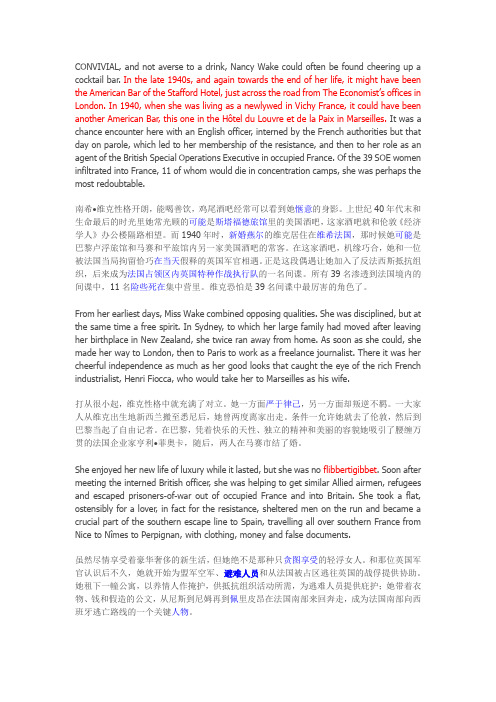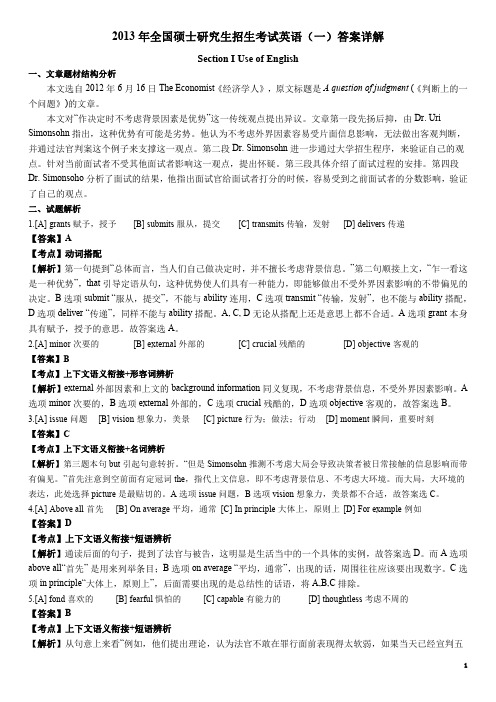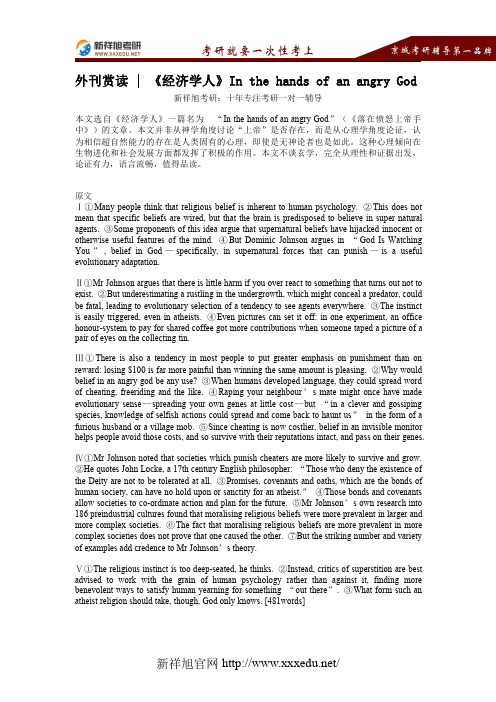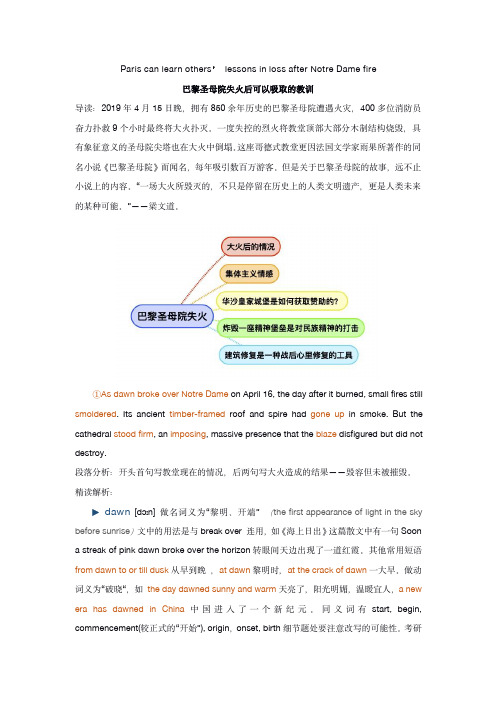经济学人两篇+翻译
经济学人翻译

CONVIVIAL, and not averse to a drink, Nancy Wake could often be found cheering up a cocktail bar. In the late 1940s, and again towards the end of her life, it might have been the American Bar of the Stafford Hotel, just across the road from The Economist’s offices in London. In 1940, when she was living as a newlywed in Vichy France, it could have been another American Bar, this one in the Hôtel du Louvre et de la Paix in Marseilles. It was a chance encounter here with an English officer, interned by the French authorities but that day on parole, which led to her membership of the resistance, and then to her role as an agent of the British Special Operations Executive in occupied France. Of the 39 SOE women infiltrated into France, 11 of whom would die in concentration camps, she was perhaps the most redoubtable.南希•维克性格开朗,能喝善饮,鸡尾酒吧经常可以看到她惬意的身影。
2013年考研英语一真题答案及解析

2013年全国硕士研究生招生考试英语(一)答案详解Section I Use of English一、文章题材结构分析本文选自2012年6月16日The Economist《经济学人》,原文标题是A question of judgment(《判断上的一个问题》)的文章。
本文对“作决定时不考虑背景因素是优势”这一传统观点提出异议。
文章第一段先扬后抑,由Dr.Uri Simonsohn指出,这种优势有可能是劣势。
他认为不考虑外界因素容易受片面信息影响,无法做出客观判断,并通过法官判案这个例子来支撑这一观点。
第二段Dr.Simonsohn进一步通过大学招生程序,来验证自己的观点。
针对当前面试者不受其他面试者影响这一观点,提出怀疑。
第三段具体介绍了面试过程的安排。
第四段Dr.Simonsoho分析了面试的结果,他指出面试官给面试者打分的时候,容易受到之前面试者的分数影响,验证了自己的观点。
二、试题解析1.[A]grants赋予,授予[B]submits服从,提交[C]transmits传输,发射[D]delivers传递【答案】A【考点】动词搭配【解析】第一句提到“总体而言,当人们自己做决定时,并不擅长考虑背景信息。
”第二句顺接上文,“乍一看这是一种优势”,that引导定语从句,这种优势使人们具有一种能力,即能够做出不受外界因素影响的不带偏见的决定。
B选项submit“服从,提交”,不能与ability连用,C选项transmit“传输,发射”,也不能与ability搭配,D选项deliver“传递”,同样不能与ability搭配。
A,C,D无论从搭配上还是意思上都不合适。
A选项grant本身具有赋予,授予的意思。
故答案选A。
2.[A]minor次要的[B]external外部的[C]crucial残酷的[D]objective客观的【答案】B【考点】上下文语义衔接+形容词辨析【解析】external外部因素和上文的background information同义复现,不考虑背景信息,不受外界因素影响。
get a foot on the career ladder该怎么翻译-每日一词3

get a foot on the career ladder该怎么翻译?-每日一词3高斋翻译TransElegant整理的CATTI和MTI备考资料原文(取自经济学人):Rich, ageing societies will find that, unless the youth of today can get a foot on the career ladder, tomorrow’s pensioners will struggle. What is more, oppressing youngsters is dangerous. Countries with lots of jobless, disaffected young men tend to be more violent and unstable, as millions of refugees from the Middle East and Africa can attest.词语解释:disaffected美[ˌdɪsəˈfɛktɪd],心怀不满的;不满的; 愤愤不平的;[例句]He attracts disaffected voters.他吸引了心怀不满的选民们。
attest美[əˈtɛst]证实,证明这句话里面的get a foot on the career ladder该如何翻译呢?career ladder人事专业术语将其翻译为“职业梯”,那通俗一点就可以说是“职业生涯的阶梯”,是一种比喻的说法,指职业晋升、职业发展。
Get a foot on 是在…获得立足之地,很多人翻译的时候都把它翻译成了一席之地,这个范围有点大,“阶梯”只能说是“立足之地”。
所以,参考译文:富裕的老龄化国家会发现,除非现在的年轻人能在职业生涯的阶梯上获得立足之地,否则将来领退休金的人会很难拿到退休金。
而且,压迫年轻人很危险。
如果一个国家有许多没有工作而又心怀不满的年轻人,那它往往更容易出现暴乱和不稳定局面,中东和非洲的数百万难民便可证实这一点。
翻译 米塞斯 维基中文页面

经济学、政治理论学学者F. A. Hayek最初是作为米塞斯的下属走近米塞斯的,其时米塞斯正在奥地利政府供职,处理一次世界大战之后奥地利战争负债的问题。
哈耶克写道,“在那里,我认识的米塞斯是一个极富效率的主管,就像John Stuart Mill说的那种,能够在两个小时之内完成一整天的工作,总是有一张干干净净的办公桌和闲暇来谈论任何事情。
我发现他是我认识的人当中最有教养和学识的人……”。
通过米塞斯的学生Murray Rothbard,哈耶克发展了米塞斯关于商业周期理论工作,这为他赢得了1974年诺贝尔经济学奖(与瑞典经济学家Gunnar Myrdal共享)的荣誉。
為了躲避國家社會主義對奧地利的威脅,米塞斯在1934年逃往瑞士的日內瓦,並在那裡擔任國際研究學院(Graduate Institute of International Studies)的教授直到1940年。
他在1940年與其他猶太人難民一道移居美國的紐約市。
他從1945年開始一直擔任纽约大学的客座教授直到1969年退休為止,不過他始終沒有從大學領取薪資,他的生計是由一些賞識他的商人,例如Lawrence Fertig,所資助的。
在此期間,米塞斯參與到由奧地利流亡者,时任紐約大學研究院成員的Richard Coudenhove-Kalergi領導的Pan-Europa movement,并著手解決當中的貨幣問題。
1947年,米塞斯與同道者一起創辦了Mont Pelerin Society。
雖則逃離了歐洲,米塞斯依然通過與Ludwig Erhard, Charles de Gaulle and Luigi Einaudi的職業關係而在戰後歐洲重建過程中發揮了巨大影響力而為人們稱道。
在美國,首先受到米塞斯工作影響的經濟學家有Benjamin Anderson, Leonard Read and Henry Hazlitt,但是像Max Eastman這樣的前激進派作者,法律學者Sylvester J. Petro,小說作者Ayn Rand都成為了米塞斯的朋友和崇拜者。
【新祥旭考研】外刊赏读 《经济学人》In the hands of an angry God

外刊赏读|《经济学人》In the hands of an angry God新祥旭考研:十年专注考研一对一辅导本文选自《经济学人》一篇名为“In the hands of an angry God”(《落在愤怒上帝手中》)的文章。
本文并非从神学角度讨论“上帝”是否存在,而是从心理学角度论证,认为相信超自然能力的存在是人类固有的心理,即使是无神论者也是如此。
这种心理倾向在生物进化和社会发展方面都发挥了积极的作用。
本文不谈玄学,完全从理性和证据出发,论证有力,语言流畅,值得品读。
原文Ⅰ①Many people think that religious belief is inherent to human psychology.②This does not mean that specific beliefs are wired,but that the brain is predisposed to believe in super natural agents.③Some proponents of this idea argue that supernatural beliefs have hijacked innocent or otherwise useful features of the mind.④But Dominic Johnson argues in“God Is Watching You”,belief in God—specifically,in supernatural forces that can punish—is a useful evolutionary adaptation.Ⅱ①Mr Johnson argues that there is little harm if you over react to something that turns out not to exist.②But underestimating a rustling in the undergrowth,which might conceal a predator,could be fatal,leading to evolutionary selection of a tendency to see agents everywhere.③The instinct is easily triggered,even in atheists.④Even pictures can set it off:in one experiment,an office honour-system to pay for shared coffee got more contributions when someone taped a picture of a pair of eyes on the collecting tin.Ⅲ①There is also a tendency in most people to put greater emphasis on punishment than on reward:losing$100is far more painful than winning the same amount is pleasing.②Why would belief in an angry god be any use?③When humans developed language,they could spread word of cheating,freeriding and the like.④Raping your neighbour’s mate might once have made evolutionary sense—spreading your own genes at little cost—but“in a clever and gossiping species,knowledge of selfish actions could spread and come back to haunt us”in the form of a furious husband or a village mob.⑤Since cheating is now costlier,belief in an invisible monitor helps people avoid those costs,and so survive with their reputations intact,and pass on their genes.Ⅳ①Mr Johnson noted that societies which punish cheaters are more likely to survive and grow.②He quotes John Locke,a17th century English philosopher:“Those who deny the existence of the Deity are not to be tolerated at all.③Promises,covenants and oaths,which are the bonds of human society,can have no hold upon or sanctity for an atheist.”④Those bonds and covenants allow societies to co-ordinate action and plan for the future.⑤Mr Johnson’s own research into 186preindustrial cultures found that moralising religious beliefs were more prevalent in larger and more complex societies.⑥The fact that moralising religious beliefs are more prevalent in more complex societies does not prove that one caused the other.⑦But the striking number and variety of examples add credence to Mr Johnson’s theory.Ⅴ①The religious instinct is too deep-seated,he thinks.②Instead,critics of superstition are best advised to work with the grain of human psychology rather than against it,finding more benevolent ways to satisfy human yearning for something“out there”.③What form such an atheist religion should take,though,God only knows.[481words]词汇短语1.wire[ˈwaɪəd]v.接通电源2.*predisposed[pri:dɪs'pəʊzd]adj.倾向于3.*proponent[prəˈpəʊnənt]n.支持者4.*rustling[ˈrʌslɪŋ]n.沙沙声5.honour-system无看守监禁制6.furious[ˈfjʊəriəs]adj.狂怒的7.*covenant[ˈkʌvənənt]n.协议8.hold upon控制力9.*sanctity[ˈsæŋktəti]n.神圣10.credence[ˈkri:dns]n.相信11.grain[greɪn]n.细粒12.*benevolent[bəˈnevələnt]adj.慈善的13.*yearning[ˈjɜ:nɪŋ]n.渴望(注:标*的为超纲词)点评Ⅰ①Many people think that religious belief is inherent to human psychology.②This does not mean that specific beliefs are wired,but that the brain is predisposed to believe in supernatural agents.③Some proponentsof this idea argue that supernatural beliefs have hijacked innocent or otherwise useful features of the mind.④But Dominic Johnson argues in“God Is Watching You”,belief in God—specifically,in supernatural forces that can punish—is a useful evolutionary adaptation.翻译:很多人认为,宗教信仰是人类心理固有的。
经济学人考研双语精读 巴黎圣母院失火后可以吸取的教训

Paris can learn others’lessons in loss after Notre Dame fire巴黎圣母院失火后可以吸取的教训导读:2019年4月15日晚,拥有850余年历史的巴黎圣母院遭遇火灾,400多位消防员奋力扑救9个小时最终将大火扑灭。
一度失控的烈火将教堂顶部大部分木制结构烧毁,具有象征意义的圣母院尖塔也在大火中倒塌。
这座哥德式教堂更因法国文学家雨果所著作的同名小说《巴黎圣母院》而闻名,每年吸引数百万游客。
但是关于巴黎圣母院的故事,远不止小说上的内容。
“一场大火所毁灭的,不只是停留在历史上的人类文明遗产,更是人类未来的某种可能。
”——梁文道。
①As dawn broke over Notre Dame on April16,the day after it burned,small fires still smoldered.Its ancient timber-framed roof and spire had gone up in smoke.But the cathedral stood firm,an imposing,massive presence that the blaze disfigured but did not destroy.段落分析:开头首句写教堂现在的情况,后两句写大火造成的结果——毁容但未被摧毁。
精读解析:►dawn[dɔːn]做名词义为“黎明、开端”(the first appearance of light in the sky before sunrise)文中的用法是与break over连用,如《海上日出》这篇散文中有一句Soon a streak of pink dawn broke over the horizon转眼间天边出现了一道红霞。
其他常用短语from dawn to or till dusk从早到晚,at dawn黎明时,at the crack of dawn一大早。
2021对外经济贸易大学MTI真题+答案
超详细!2021对外经济贸易大学MTI真题+答案211翻译硕士英语一、单选20题近义词辨析untacheduntachable unequal unequable固定搭配poverty alleviation(脱贫)depreciationvolatile “v”开头的很多词意辨析consultancy和 redundancy 区别很多题都是,一道题两个空,一般只清楚一个空,另一个空单词不认识,很难选二、文体改错10题comma price, run on, fragment 比较多,也有correct,choppy比较少,没有stringy三、阅读,2篇常规阅读,1篇5选5,1篇判断正误第一篇2017年12月六级真(第一套),判断正误Our world now moves so fast that we seldom stop tosee just how far we have come in just a few years. The latest iPhone 6s, forexample, has a dual-core processor and fits nicely into your pocket. comparison,you would expect to find a technological specification like this on yourstandard laptop in an office anywhere in the world.It's no wonder that new applications for theInternet of Things are moving ahead fast when almost every new device we buy hasa plug on the end of it or a wireless connection to the internet. Soon, our currentsmartphone lifestyle will expand to create our own smart home lifestyle too.All researches agree that close to 25 billiondevices, things and sensors will be connected 2020 which incidentally isalso the moment that Millennials (千禧一代) are expected to make up 75 percent of our overallworkforce, and the fully connected home will become a reality for large numbersof people worldwide.However, this is just the tip of the proverbialiceberg as smart buildings and even cities increasingly become the norm asleaders and business owners begin to wake up to the massive savings thattechnology can deliver through connected sensors and new forms of automationcoupled with intelligent energy and facilities management.Online security cameras, intelligent lighting and awealth of sensors that control both temperature and air quality are offering anunprecedented level of control, efficiency, and improvements to what were onceclassed necessary costs when running a business or managing a large building.We can expect that the ever-growing list ofdevices, systems and environments remain connected, always online and talkingto each other. The big benefit will not only be in the housing of this enormousand rapidly growing amount of data, but will also be in the ability torun realtime data analytics to extract actionable and ongoing knowledge.The biggest and most exciting challenge of thistechnology is how to creatively leverage this ever-growing amount of data todeliver cost savings, improvements and tangible benefits to both businesses andcitizens of these smart cities.The good news is that most of this technology isalready invented. Let's face it, it wasn't too long ago that the idea ofworking from anywhere and at anytime was some form of a distant Utopian (乌托邦式的) dream, and yet now we can perform almost anyoffice-based task from any location in the world as long as we have access tothe internet.It's time to wake up to the fact that making smartbuildings, cities and homes will dramatically improve our quality of life inthe years ahead.第二篇,选自2019年5月一篇经济学人文章Sleepless in Silicon ValleyWhy the techie obsession with sleep technologymakes perfect senseFirst, close the blackout blinds in your bedroom.Eat dinner at 4pm, and do not eat or drink anything after 6pm. Put on yourblue-light blocking glasses at 8pm. Set your bedroom temperature to 67oF{19.4C) and your electric blanket to 69.8oF {21 C). At 8.45pm, meditate forfive to ten minutes. Switch on your deep- wave sound machine. Put on yourQurasleep tracking ring. You are now, finally, ready for slumber. This may allsound a bit over the top. But this is the "sleep hygiene" routinedescribed in a recent blog post Bryan Johnson, who sold his previous companyto eBay for $800m and is now chief executive of Kernel, a startup developingbrain-computer interfaces. He admits that his sleep routine has "decimatedmy social life”, and that his partner sleeps in a different room, but says allthis troubleis worth it, because it has boosted his level of "deepsleep" as much as 157%. He has bought Oura rings for all his employees.Mr Johnson does not expect other people to copy hisroutine, but made it public to encourage the sharing of sleep habits and tips.Like many other techies, he regards sleep hygiene as an effective way tomaintain mental health, boost cognition and enhance productivity. In its mostrecent funding round, backers of Oura, the Finnish maker of the high-tech ring,included the co- founders of YouTube and Twitch, along with alumni ofFacebook,Skype and . The ring's most famous user is Jack Dorsey, the boss ofTwitter, whose unusual wellness regime-which also incorporates near-infraredsaunas, radiation blocking Faraday tents, fasting and cryotherapy- prompted theNew York Times this month to dub him “Gwyneth Paltrow for Silicon Valley”. Fortech tycoons, it seems, sleep is the new fitness.Those who want to monitor and improve their sleephaveno shortage of gadgets to choose from. As well as electric blankets andmattress- chillers, sound machines and "decimated my social life” smartrings, there are also smart pillows, sleep-tracking watches and bracelets,intelligentsleep masks, brain-stimulating headbands, bedside sleep sensors andcountless sleep- monitoring apps. The market for sleep technology was worth$58bn in 2014 and is expected to grow to $81bn 2020, according toPersistence, a market-research firm. Big companies in the field includehousehold names such as Apple, Bose, Nokia and Philips. After Mr Dorsey'senthusiastic endorsement, the Oura rings are back- ordered four to sixweeks.The mania for sleep technology makes perfect sensefor the tech industry, combining as it does several existing trends. For astart, it fits with the industry's metrics -driven worldview. Techies obsessabout OKRs {objectives and key results), KPIs {key performance indicators) anddigital-analytics dashboards showing the performance of specific products andfeatures. Applying similar techniques to sleep and other aspects of theirpersonal lives, an approach known as the "quantified self" seems alogical step. As those in the startup world like to say, channeling Peter Drucker,a management guru, "what's measured improves."Sleep- tracking also aligns neatly with Silicon Valley'scult of productivity, and the constant search for "life hacks" thatwill make entrepreneurs more effective, efficient and successful. This ranges fromwearing the same clothes every day, Steve Jobs-style (thus avoiding wastingtime deciding what to put on), to fastidious fitness routines and complicateddiets. Elaborate sleep regimes slot right in, because they promise clarity ofthought and improved cognitive performance. They also let people extend theirquantified· self and life- -hacking efforts into the one part of the day that waspreviously untouched: shut-eye.Relentlessly pursuing productivity only whileyou are awake is for wimps. Sleep -tracking means you can do it round theclock. Oura describes its sensor packed ring as a "secret weapon forpersonal improvement"- -another way to get ahead.1.下列说法符合文章标题的是?A how to?B how to achieve self-improvementC how to monitor your sleepingD seeping hyhegnie and technology that can improveefciency2.What dose "Iife hacks "mean?A life tipsB?C?D privacy monitoring3. What does the sentence mean "decimated m ysocial life”4. What does the sentence mean "the Oura ringsare back- ordered four to six weeks."?5.搞科技的为啥喜欢这个?选项为D.以上全部第三篇: Cosco CiscoIntel 这些公司预见未来,制定未来发展计划的情况,哪些公司可以紧跟时代潮流。
目的论指导下软新闻汉译翻译策略——以《经济学人》为例
目的论指导下软新闻汉译翻译策略——以《经济学人》为例摘要:本文在对德国功能翻译理论进行简要梳理的基础上,探讨目的论在软新闻翻译中的运用。
结合软新闻这一文体,选取《经济学人》作为材料,通过实例探讨目的论在解决软新闻翻译过程中存在的问题以及为解决这些问题而采取的相应翻译策略。
关键词:目的论;软新闻;翻译策略;经济学人一、引言当前,国际形势仍存在很多不稳定性及不确定性因素,各国意识形态冲突加剧,而新闻是实现国家之间信息交流、文化传递的最直接手段。
在此过程中,新闻翻译的作用尤为重要。
与题材较为严肃的硬新闻不同,软新闻更加贴近大众的生活,激发人们的阅读兴趣。
因此,在中外文化交流过程中处于更为重要的地位。
在分析了软新闻研究及其自身特点之后,笔者认为汉斯·弗米尔的目的论能够较好的指导软新闻翻译。
目的论强调翻译中的最高法则是“目的性原则”,翻译的目的决定了翻译的策略和方法,这与软新闻吸引读者同时传播信息的宗旨一致。
二、目的论概述目的论最早是由功能主义翻译理论家维米尔提出的。
Vermeer认为“目标文本由其Skopos决定,必须内部连贯,与源文本一致”。
后来经过Nord等人的进一步发展,形成了一个理论体系。
目的论的首要原则是使目的语接受者,即读者理解目的语的意义,并在目的语文化和交际环境中产生意义。
根据维米尔的理论,目的论有三个原则:(1)目的原则。
这是首要规则。
这一原则认为,翻译是由翻译所要达到的目标决定的。
(2)连贯原则。
它意味着译文必须为读者所理解,并且在读者的文化和所使用的交流环境中有意义。
(3)忠实原则。
它是指译者对原文的忠实,这种忠实取决于原文和译者对原文的理解。
“在此基础上,Nord提出了忠实原则,即原文的目的与作者的意图相一致。
当目的原则和所要求的交际目的与译文不一致时,应遵循目的原则,违反忠实原则。
三、软新闻翻译及其特点(一)软新闻的定义软新闻是指富有人情味、纯知识、纯趣味的新闻。
它和人们的切身利益并无直接关系;向受众提供娱乐,使其开阔眼界,增长见识,陶冶情操,如社会新闻、体育新闻等等。
考研英语《经济学人》翻译实践+词汇积累
考研英语《经济学⼈》翻译实践+词汇积累(6)This picture of dedication and loneliness stands in sharp contrast to the popular image. Mr Zhang says he is as disgusted as the general public is with official corruption. He notes that, like many civil servants, he works in a job without the kind of power that could be abused. The leaders in his office work longer hours than he does and still ride bicycles to work.虽尽⼼尽⼒,但总感到孤独,与⼤众对公务员的印象形成鲜明对⽐。
Zhang Minfu说,与普通⼤众⼀样,⾃⼰也痛恨贪腐。
他特别提醒,如同众多公务员那般,⾃⼰没有可滥⽤的职权。
其办公室的领导⼯作时间⽐他还长,现在仍是蹬车上班。
译后习得Dedication解释:V-T If you say that someone has dedicated themselves to something, you approve of the fact that they have decided to give a lot of time and effort to it because they think that it is important.投⾝举例:For the next few years, she dedicated herself to her work.随后的⼏年⾥,她全⾝⼼地投⼊⼯作。
解释:ADJ投⾝于…的举例:He's quite dedicated to his students.他奉献很多给他的学⽣们。
3英语阅读-经济学人《Economics》双语版-Foodfirmsandfat-fighters
(2):食品公司与减肥斗士【翻译交流】Feb 9th 2006From The Economist Global AgendaFood firms and fat-fighters食品公司与减肥斗士Five leading food companies have introduced a labelling scheme for their products in the British market, in an attempt to assuage critics who say they encourage obesity. But consumer groups are unhappy all the same. Is the food industry, like tobacco before it, about to be *engulfed[1]by a wave of lawsuits brought on health grounds?五家业内领先的食品公司采取了一项方案,就是在其投入英国市场的食品上作出标注,力图堵住那些说他们鼓励肥胖的批评人士的嘴。
不过,消费者团体仍然不开心。
食品业会像之前的烟草一样,被卷入一场关乎健康的诉讼之中吗?KEEPING fit requires a combination of healthy eating and regular exercise. On the second of these at least, the world’s food companies can claim to be setting a good example :they have been working up quite a sweat in their attempts to fend off assaults by governments, consumer groups and lawyers who accuse them of peddling products that encourage obesity. This week saw the unveiling of another industry initiative :five leading food producers—Danone, Kellogg, Nestlé, Kraft and PepsiCo—introduced a labelling scheme for the British market which will show “guideline daily amounts” for calories, fats, sugar and salt on packaging. The new labels will start to appear on the firms’ crisps, chocolate bars, cheese slices *and the like[2] over the next few months. A number of other food giants, such as Cadbury Schweppes and Masterfoods, have already started putting guideline labels on their products.将健康的饮食习惯和经常性的锻炼二者结合才可以让身体保持健康。
- 1、下载文档前请自行甄别文档内容的完整性,平台不提供额外的编辑、内容补充、找答案等附加服务。
- 2、"仅部分预览"的文档,不可在线预览部分如存在完整性等问题,可反馈申请退款(可完整预览的文档不适用该条件!)。
- 3、如文档侵犯您的权益,请联系客服反馈,我们会尽快为您处理(人工客服工作时间:9:00-18:30)。
Disney Star Wars, Disney and myth-makingHow one company came to master the business of storytellingFROM a galaxy far, far away to a cinema just down the road: “The Force Awakens”, the newest instalment of the Star Wars saga, is inescapable this Christmas. The first Star Wars title since Lucasfilm, the owner of the franchise, was acquired by Disney in 2012 for $4.1 billion, it represents more than just the revival of a beloved science-fiction series. It is the latest example of the way Disney has prospered over the past decade from a series of shrewd acquisitions (see article). Having bought Pixar, Marvel and Lucasfilm, Disney has skilfullycapitalised on their intellectual property—and in so doing, cemented its position as the market leader in the industrialisation of mythology. Its success rests on its mastery of the three elements of modern myth-making: tropes, technology and toys.From Homer to Han SoloStart with the tropes. Disney properties, which include everything from “Thor” to “Toy Story”, draw on well-worn devices of mythic structure to give their stories cultural resonance. Walt Disney himself had an intuitive grasp of the power of fables. George Lucas, the creator of Star Wars, is an avid student of the work of Joseph Campbell, an American comparative mythologist who outlined the “monomyth” structure in which a hero answers a call, is assisted by a mentor figure, voyages to another world, survives various trials and emerges triumphant. Bothfilm-makers merrily plundered ancient mythology and folklore. The Marvel universe goes even further, directly appropriating chunks of Greco-Roman and Norse mythology. (This makes Disney's enthusiasm for fierce enforcement of intellectual-property laws, and the seemingly perpetual extension of copyright, somewhat ironic.)The internal mechanics of myths may not have changed much over the ages, but the technology used to impart them certainly has. That highlights Disney's second area of expertise. In Homer's day, legends were passed on in the form of dactylic hexameters; modern myth-makers prefer computer graphics, special effects, 3D projection, surround sound and internet video distribution,among other things. When Disney bought Lucasfilm it did not just acquire the Star Wars franchise; it also gained Industrial Light & Magic, one of the best special-effects houses in the business, whose high-tech wizardry is as vital to Marvel's Avengers films as it is to the Star Wars epics. And when Disney was left behind by the shift to digital animation, it cannily revitalised its own film-making brand by buying Pixar, a firm as pioneering in its field as Walt Disney had been in hand-drawn animation. Moreover, modern myths come in multiple media formats. The Marvel and Star Wars fantasy universes are chronicled in interlocking films, television series, books, graphic novels and video games. Marvel's plans are mapped out until the mid-2020s.But these days myths are also expected to take physical form as toys, merchandise and theme-park rides. This is the third myth-making ingredient. Again, Walt Disney led the way, licensing Mickey Mouse and other characters starting in the 1930s, and opening the original Disneyland park in 1955. Mr Lucas took cinema-related merchandise into a new dimension, accepting a pay cut as director in return for all the merchandising rights to Star Wars—a deal that was to earn him billions. Those rights now belong to Disney, and it is making the most of them: sales of “The Force Awakens” merchandise, from toys to clothing, are expected to be worth up to $5 billion alone in the coming year. In all, more than $32 billion-worth of Star Wars merchandise has been sold since 1977, according to NPD Group, a market-research firm. Even Harry Potter and James Bond are scruffy-looking nerf-herders by comparison.Those other franchises are reminders that Disney's approach is not unique. Other studios are doing their best to imitate its approach. But Disney has some of the most valuable properties and exploits them to their fullest potential. It is particularly good at refreshing and repackaging its franchises to encourage adults to revisit their childhood favourites and, in the process, to introduce them to their own children. This was one reason why Pixar, whose films are known for their cross-generational appeal, was such a natural fit. Now the next generation is being introduced to Star Wars by their nostalgic parents. At the same time, Disney has extended its franchises by adding sub-brands that appeal to particular age groups: children's television series spun off from Star Wars, for example, or darker, more adult tales from the Marvel universe, such as the “Daredevil” and “Jessica Jones” series on.Do, or do not—there is no tryWhat explains the power of all this modern-day mythology? There is more to it than archetypal storytelling, clever technology and powerful marketing. In part, it may fill a void left by the decline of religion in a more secular world. But it also provides an expression for today's fears.T he original “Star Wars” film, in which a band of plucky rebels defeat a technological superpower, was a none-too-subtle inversion of the Vietnam war. The Marvel universe, originally a product of the cold-war era, has adapted well on screen to a post-9/11 world of surveillance and the conspiratorial mistrust of governments, large corporations and the power of technology. Inuncertain times, when governments and military might seem unable to keep people safe or stay honest, audiences take comfort in the idea of superheroes who ride to the rescue. Modern myths also have the power to unify people across generations, social groups and cultures, creating frameworks of shared references even as other forms of media consumption become ever more fragmented.Ultimately, however, these modern myths are so compelling because they tap primordial human urges—for refuge, redemption and harmony. In this respect they are like social-media platforms, which use technology to industrialise social interaction. Similarly, modern myth-making, reliant though it is on new tools and techniques, is really just pushing the same old buttons in stone-age brains. That is something that Walt Disney understood instinctively—and that the company he founded is now exploiting so proficiently.迪士尼星球大战,迪士尼和神话创造一个公司如何成为兜售故事的商业传奇从遥远的星际抵达你周边的电影院—《星球大战7:原力觉醒》这部星战系列的最新影片就在圣诞期间上映,不容错过。
